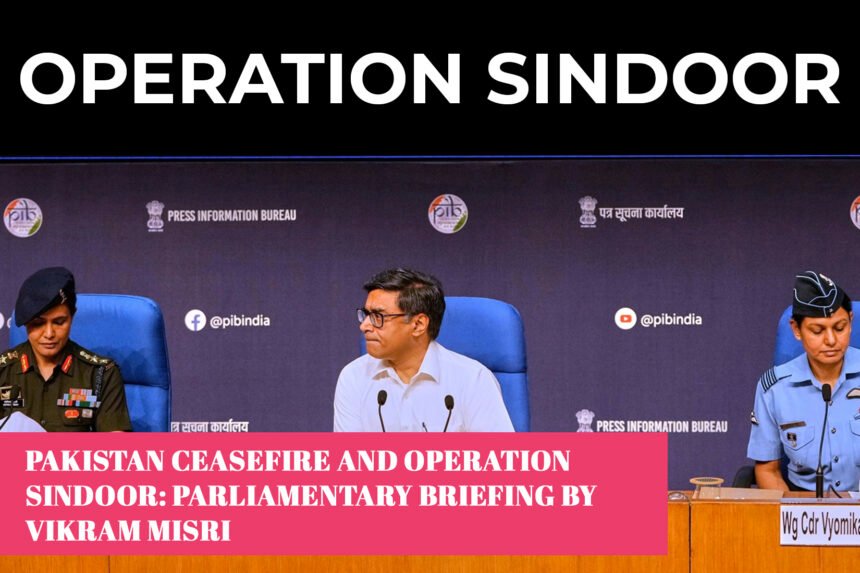Foreign Secretary Vikram Misri briefs Parliament Committee on May 19, 2025, about the recent India-Pakistan Ceasefire that erupted after the Pahalgam terror attack. This high-level meeting, chaired by Congress MP Shashi Tharoor, will cover the latest developments in India’s foreign policy regarding Pakistan and provide lawmakers with a detailed account of the events and India’s response. The session comes in the wake of Operation Sindoor, a major military action by India, and the subsequent ceasefire agreement reached between the two countries on May 10, 2025.
Background: The Pahalgam Attack and Rising Tensions
The immediate trigger for the conflict was a terrorist attack in the Baisaran Valley near Pahalgam, Jammu and Kashmir, on April 22, 2025. The attack claimed the lives of 26 people, mostly Hindu tourists, and was claimed by The Resistance Front (TRF), a group India accuses of being backed by Pakistan. In response, Prime Minister Narendra Modi vowed strong action, blaming Pakistan for supporting cross-border terrorism charge Pakistan firmly denied.
Escalation to Military Conflict
Tensions quickly escalated along the Line of Control (LoC) with cross-border firing and artillery exchanges starting April 24, 2025. Diplomatic ties deteriorated as India expelled Pakistani diplomats, recalled its staff, suspended visas, and withdrew from the Indus Waters Treaty. Pakistan responded with trade restrictions, closed its airspace, and suspended key agreements.
On May 7, 2025, India launched Operation Sindoor series of precision missile and drone strikes targeting what it described as terrorist infrastructure belonging to groups like Jaish-e-Mohammed and Lashkar-e-Taiba in Pakistan-administered Kashmir and Punjab province. Indian forces used advanced weaponry, including Rafale jets and BrahMos missiles, to strike nine sites over a 23-minute window.
Pakistan, in turn, claimed that Indian strikes hit civilian areas and religious sites, while India insisted the targets were exclusively militant camps. In retaliation, Pakistan launched Operation Bunyan-un-Marsoos, targeting Indian military installations and claiming to have damaged several air bases and defense assets. India rejected Pakistan’s statements about causing heavy destruction, saying the actual damage was very limited and supporting this by sharing satellite photos as proof.
The Four-Day Conflict and Ceasefire
The fighting, which lasted from May 7 to May 10, 2025, marked one of the most intense standoffs between the two nuclear-armed neighbors in decades. Both sides employed drones and missiles, and for the first time, drone warfare played a significant role in the conflict. On May 10, the conflict reached its highest point as both India and Pakistan carried out strikes targeting each other’s military bases and infrastructure. This intense exchange involved missile and drone attacks, with both sides aiming at key defense sites deep within each other’s territory.

As tensions rose, countries around the world became worried that the conflict might escalate into a larger war. Global leaders called for restraint and urged both sides to avoid further violence. Diplomatic intervention, including from the United States, helped broker a ceasefire. On May 10, after hotline talks between the Directors General of Military Operations (DGMOs) of both countries, India and Pakistan agreed to halt all military actions. The ceasefire has largely held since then, with commercial flights resuming and a return to relative normalcy along the border.
Parliamentary Briefing and Policy Developments
Foreign Secretary Vikram Misri’s briefing to the Parliamentary Committee is seen as a crucial step in keeping lawmakers informed about the government’s strategy and the evolving situation. The panel, led by Shashi Tharoor, will review the military, diplomatic, and policy responses to the conflict on May 19 and 20, 2025.
At the same time, a separate parliamentary committee led by BJP MP Rajiv Pratap Rudy is turning its attention to water resource issues, which have become even more important after India suspended the Indus Waters Treaty with Pakistan. This committee will discuss topics like how to better manage floods, protect riverbanks, and handle the challenges that come with rivers crossing national borders. The suspension of the water-sharing agreement has made these discussions more urgent, as it affects not just diplomatic relations but also the management of vital water resources for both countries. The committee’s work will involve reviewing ways to safeguard Indian interests, ensure effective flood control, and address any new risks that have come up because of the treaty’s halt.
International Outreach
Understanding the worldwide impact of the recent conflict and India’s strong stance against terrorism, the government has planned to send representatives from all political parties to 33 important cities around the globe. These delegations will meet with international leaders to explain India’s position, share details about its actions, and seek global support in its fight against terrorism. This move aims to build international understanding and cooperation during a critical time. These delegations will brief foreign leaders about India’s stance, the details of Operation Sindoor, and the country’s resolve to respond firmly to terrorism. This diplomatic push aims to build international support and highlight the threat posed by cross-border terror networks.
Operation Sindoor: A Shift in India’s Strategy
The events surrounding Operation Sindoor represent a significant evolution in India’s approach to dealing with terrorism originating from Pakistan. Instead of relying solely on diplomatic pressure, India opted for direct military action to degrade the capacity of terrorist groups and impose costs on their sponsors. This marks a shift from previous strategies, signaling a more assertive and risk-tolerant posture in responding to provocations.
The operation also showcased India’s growing use of advanced military technology, including precision-guided munitions and drones, to achieve its objectives with minimal collateral damage. Indian officials emphasized that the strikes were carefully planned to avoid civilian casualties and focused exclusively on terrorist infrastructure.
Aftermath and Ongoing Challenges
While the ceasefire has brought temporary calm, both India and Pakistan continue to trade accusations over the conduct and impact of the military operations. Each side claims to have emerged stronger, and there are competing narratives about the extent of damage and success.
India remains vigilant, with security forces on high alert to prevent further attacks. The government’s decision to brief the Financial Action Task Force (FATF) on evidence of terror infrastructure in Pakistan underscores its commitment to internationalizing the issue of cross-border terrorism.
The recent India-Pakistan conflict, triggered by the Pahalgam terror attack and culminating in Operation Sindoor, has highlighted the volatility of the region and the risks associated with unresolved disputes. The swift escalation and subsequent ceasefire demonstrate both the dangers and the capacity for restraint between the two countries.
Foreign Secretary Misri’s briefing to Parliament is part of a broader effort to ensure transparency, build consensus, and keep India’s response aligned with national interests. As India steps up its diplomatic outreach and reviews its security policies, the focus remains on preventing future attacks and maintaining stability in a sensitive and complex neighborhood.
MUST READ: Pahalgam Attack Aftermath: Economic Ramifications for Pakistan Due to Attari Closure










